Poor Slippery Jack doesn't get much respect as an edible mushroom. But if you get to know him, he is a decent fellow. He's worth inviting into your own home for dinner or lunch. I agree with the old adage - "A free wild mushroom on my plate is worth 10 domestic mushrooms that I have to go to the store and buy." ; )
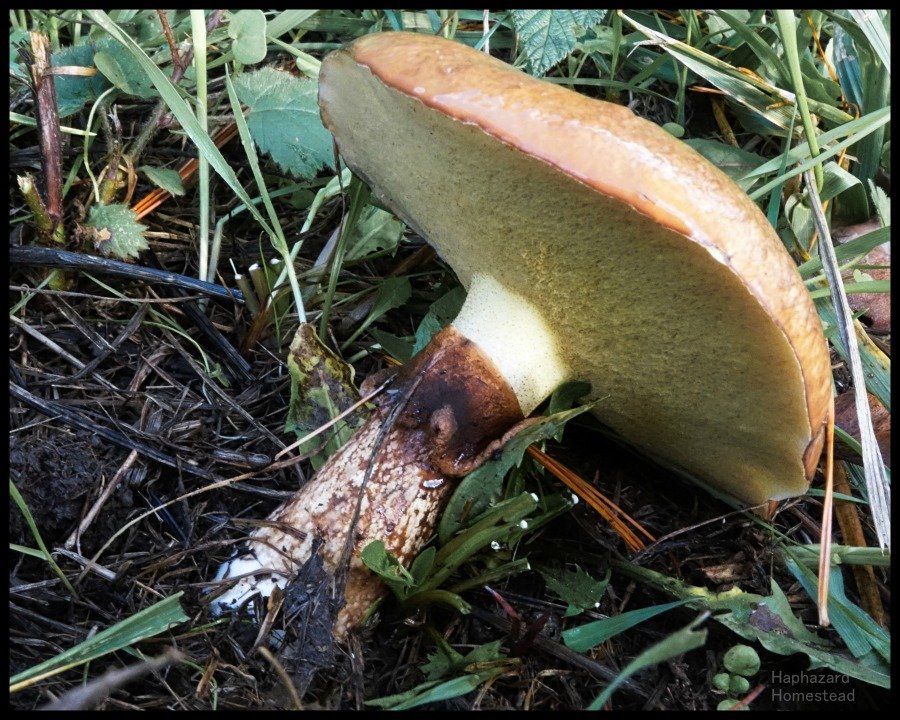
In Part 1, meet Slippery Jack. Find out where he hangs out and some details about his lifestyle. And learn how to take him home. In Part 2, learn to clean him up, take him to dinner, and keep him in shape for more than a couple days. Once you get to know him well, you may even want to introduce him to your friends and family!
Meet Slippery Jack
So who is this Slippery Jack? He is Suillus luteus, a member of the Bolete family. How do we know? He looks like a regular mushroom growing from the ground. But look underneath! He doesn't have gills like so many other mushrooms. Nope. He's got pores underneath his cap - a layer of little tubes that hang from under his cap. They are light yellow when he's young, and turn darker and more olive as he gets old. But those pores are the give-away. He's in the Bolete family, for sure!
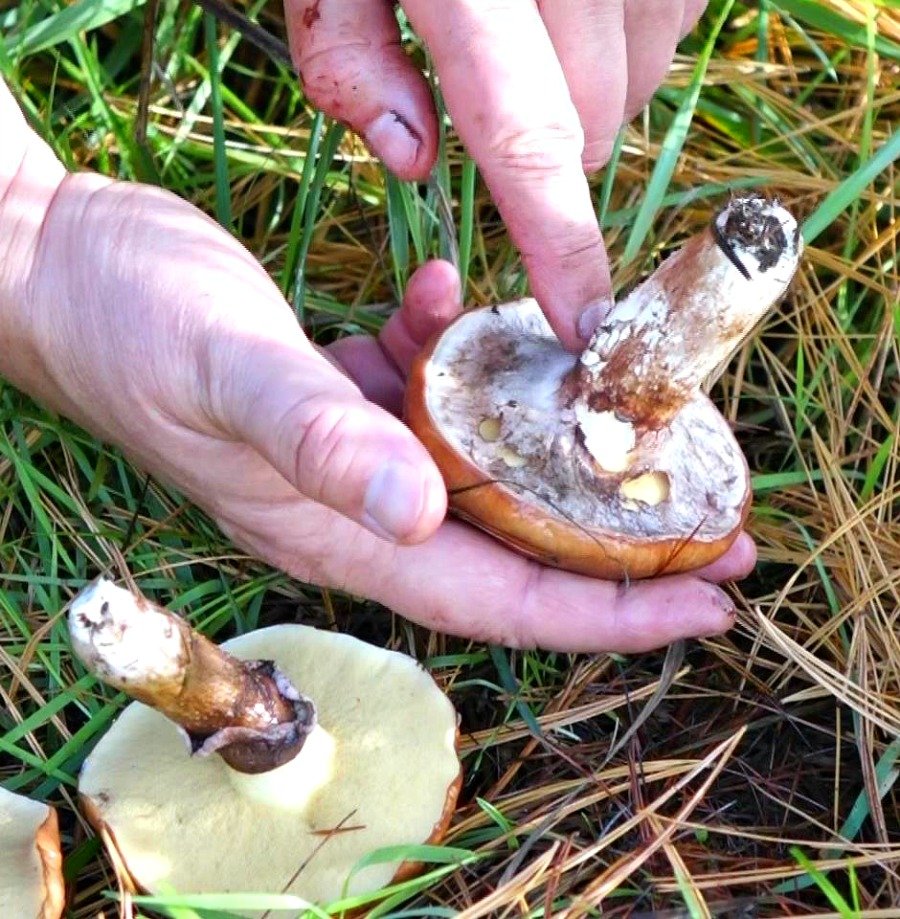
And, holy smokes, touch his cap - it is slimy and sticky, all at the same time. It is more slimy and sticky than a slobbery dog! That's what the mushroom books call viscid. The grass and all kinds of other debris stick to that cap. So even if the weather has dried out, you can tell that his cap was sticky earlier on.
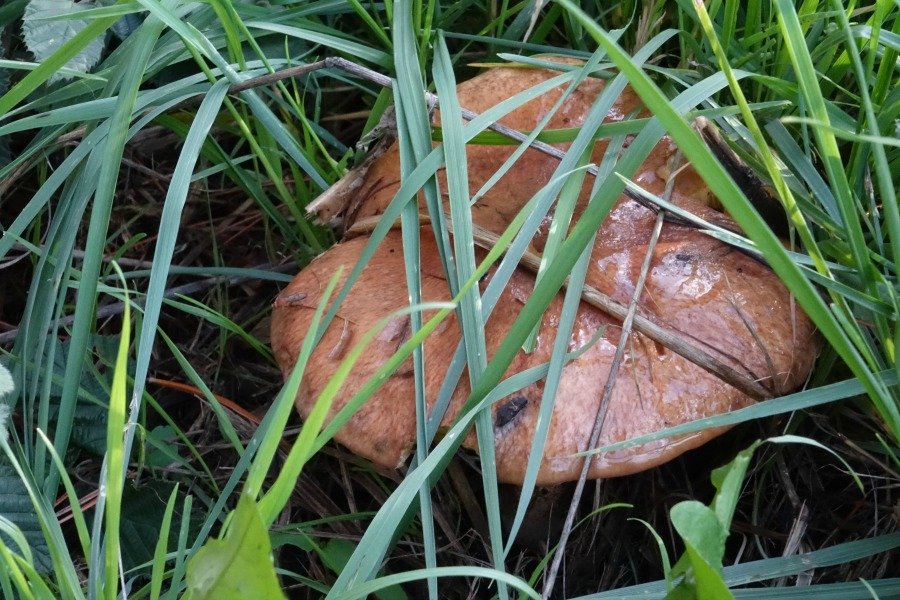
But that cap and the pores are not enough to identify the real Slippery Jack. There are more than a few slippery Suillus out there - dozens and dozens. What about Tamarack Jack, or even Slippery Jill? The key is to take a look at his stalk. His stalk has three key features - if all three match, it's Slippery Jack. Here they are:

- On the lower part of his stalk, there is a purplish-hued net-like pattern - a reticulated pattern.
- The top part of this stalk is white or light yellow. But look closely. His upper stalk has little pinkish-brown dots - granular dots.
- And in between, a greasy, slimy, sticky, purplish-brown skirt-like ring. That ring doesn't move up or down. As soon as you touch it, it sticks to you and gets all messed up. Even left alone that ring will fall apart before too long and just leave a gross mess between the upper and lower part of Slippery Jack's stalk.
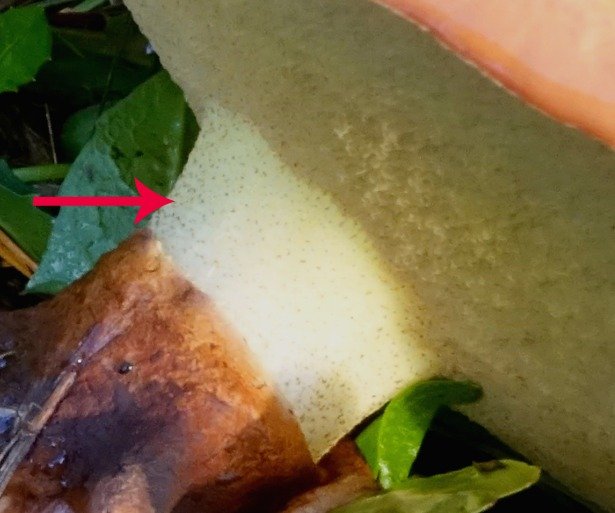
Here's a quick opportunity to win 2 Steem: Those three bolded items in the list above, help me to remember the key features of the Slippery Jack. But they are also words in a great song by one of my favorite singer-songwriters. The first person who can name that song and artist, in a comment below, will win 2 Steem.
Find Slippery Jack At Home
So where can we find Slippery Jack? Well, he hangs tight with his buddies. His buddies are Pine trees (Pinus spp.). But sometimes he hangs with the Firs (Abies spp.) and Spruce (Picea spp.). They both are in the Pine Family (Pinaceae), too. Slippery Jack showed up at my place after I planted an Eastern White Pine. He has not showed up by my Ponderosa Pine or Sugar Pine, yet. He has started hanging out with my Noble Fir - and that's a good thing!
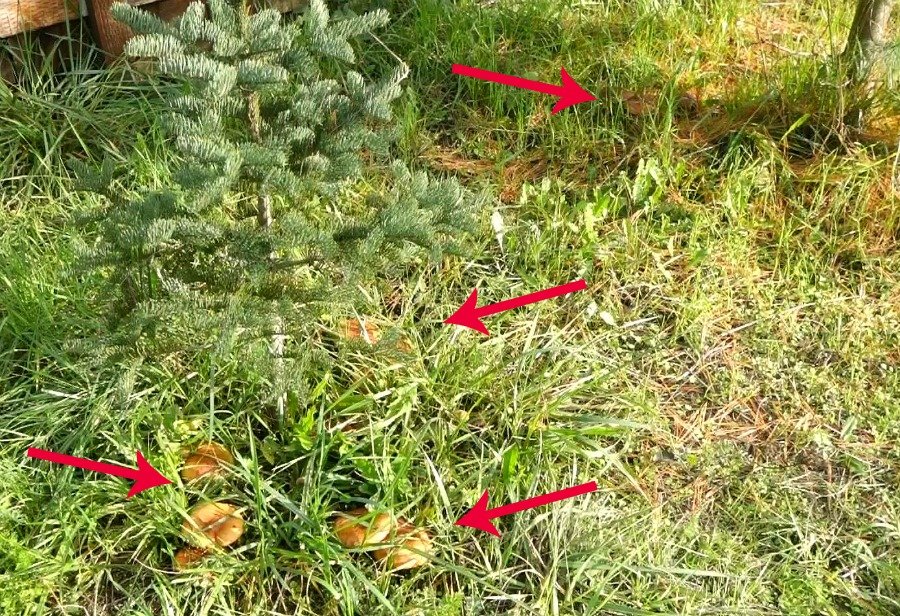
Why do they hang out together? Slippery Jack and his tree buddies have a symbiotic, mycorrhizal relationship -- that's hanging tight, alright! Slippery Jack lives mostly underground and works his way into the roots of those pine trees. He helps them get water and nutrients from the soil. And the pine trees give him some of the sugars and starches that they make from photosynthesis.
That means when I find Slippery Jack, he is going to be there for a long time. I will be able to see him pretty much every year. And there are usually a lot of them, not just one or two. I'm not going to wipe him out by harvesting most of his mushrooms. Nope. His mushrooms are like fruits, like apples on an apple tree. Most of Slippery Jack is underneath the ground and in the roots of the trees.

Slippery Jack only comes above ground after cool, wet weather. That's October and November here in Oregon's Willamette Valley. I'm hoping to see more of him if our weather stays warm into December, but I haven't seen him since mid-November. I know he's still there, though. He's just hanging with the roots of his tree buddies and waiting until next year.
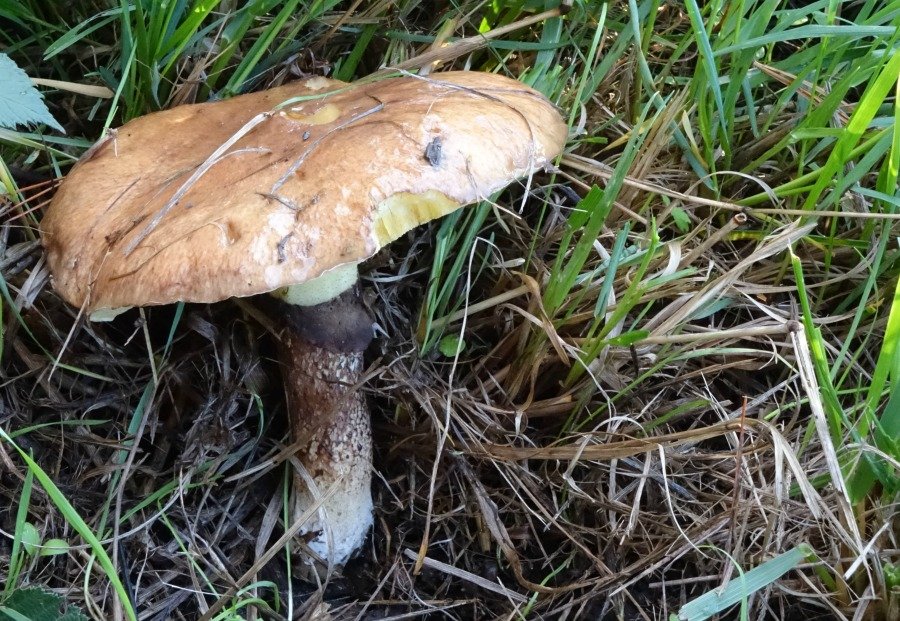
Invite Slippery Jack To Your Home
OK, I admit, Slippery Jack is sticky and slimy. But if he is young and solid, he is worth taking home to enjoy, in a variety of ways. If his pores are brown, or if they don't spring back when I press on them, he is too old for me. It's likely he's infested by that point, too, by the maggots that seem to follow him everywhere. Whether young or old, if he is infected with mold, I leave him be, too. I don't want any part of that scene. No.
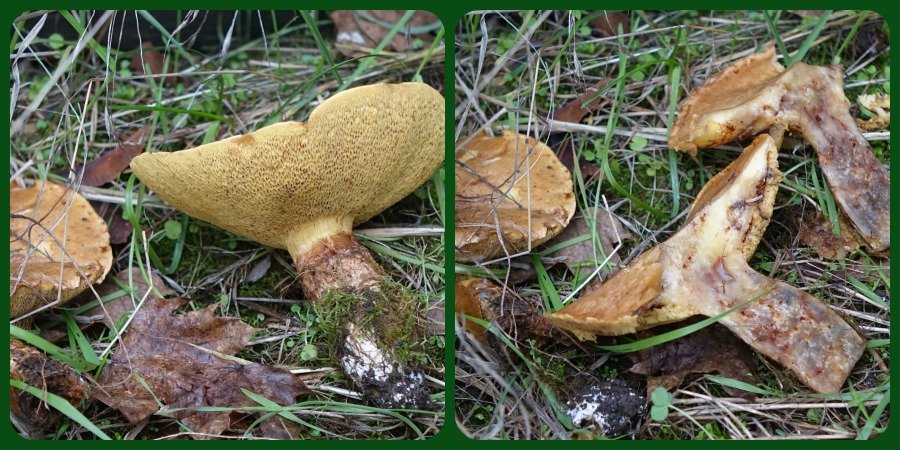
When I pick up Slippery Jack, I put him in a basket or a paper sack - never a plastic bag or tub. He will go bad, so fast, if I do that to him. I should cut off the base of his stalk, to make my job in the kitchen easier. But I have to admit, I don't always do that. I should, though, because those little maggots hang out in the stalk at the start. If I cut them off at the base, I will have a lot fewer problems when I get home!
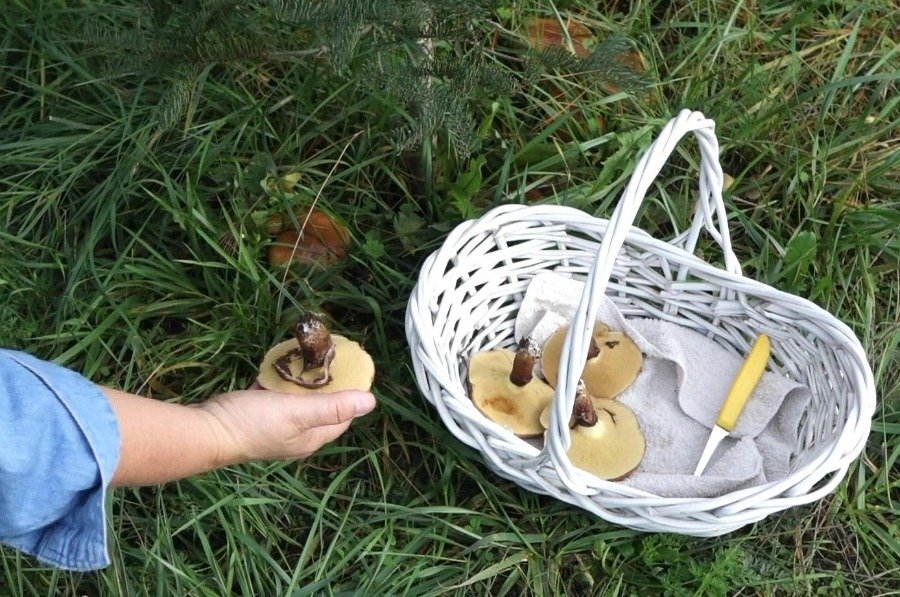
What Do You Think?
Have you ever met Slippery Jack? Have you met any of the other Suillus mushrooms? Do you take them home for dinner? I really want to know! I hope you come back for Part 2 of getting to know Slippery Jack. In Part 2, Slippery Jack gets cleaned up and dressed for dinner. Find out how to keep him in shape for more than a couple days, too.
I write about foraging because I believe that we can all have lives that are richer, more secure, more grounded, and more interesting by getting to know the plants and the land around us – in our yards, our parks, and our wilderness.
I would like Steemit to be the premier site for Foraging on the Internet! If you have any thoughts about foraging, or experiences to share, write a post and be sure to use the Foraging tag. And check out the @foraging-trail to see curated quality posts about foraging. Happy Foraging!
Plant List
- Slippery Jack mushroom - Suillus luteus
- Tamarack Jack mushroom - Suillus grevillei
- Slippery Jill mushroom - Suillus subolivaceious
- Eastern White Pine - Pinus strobus
- Ponderosa Pine - Pinus ponderosa
- Sugar Pine - Pinus lambertiana
- Noble Fir - Abies procera
** Haphazard Homestead **
*** foraging, gardening, nature, simple living close to the land ***
All content is 100% Haphazard Homestead - photos and all!
I participate in Operation Translation. All my posts are available for translation under the rules listed on the linked post from @papa-pepper. Logo provided by @oepc85. Post goes 100% to Steem Power! Logo provided by @merej99

*** foraging, gardening, nature, simple living close to the land ***

